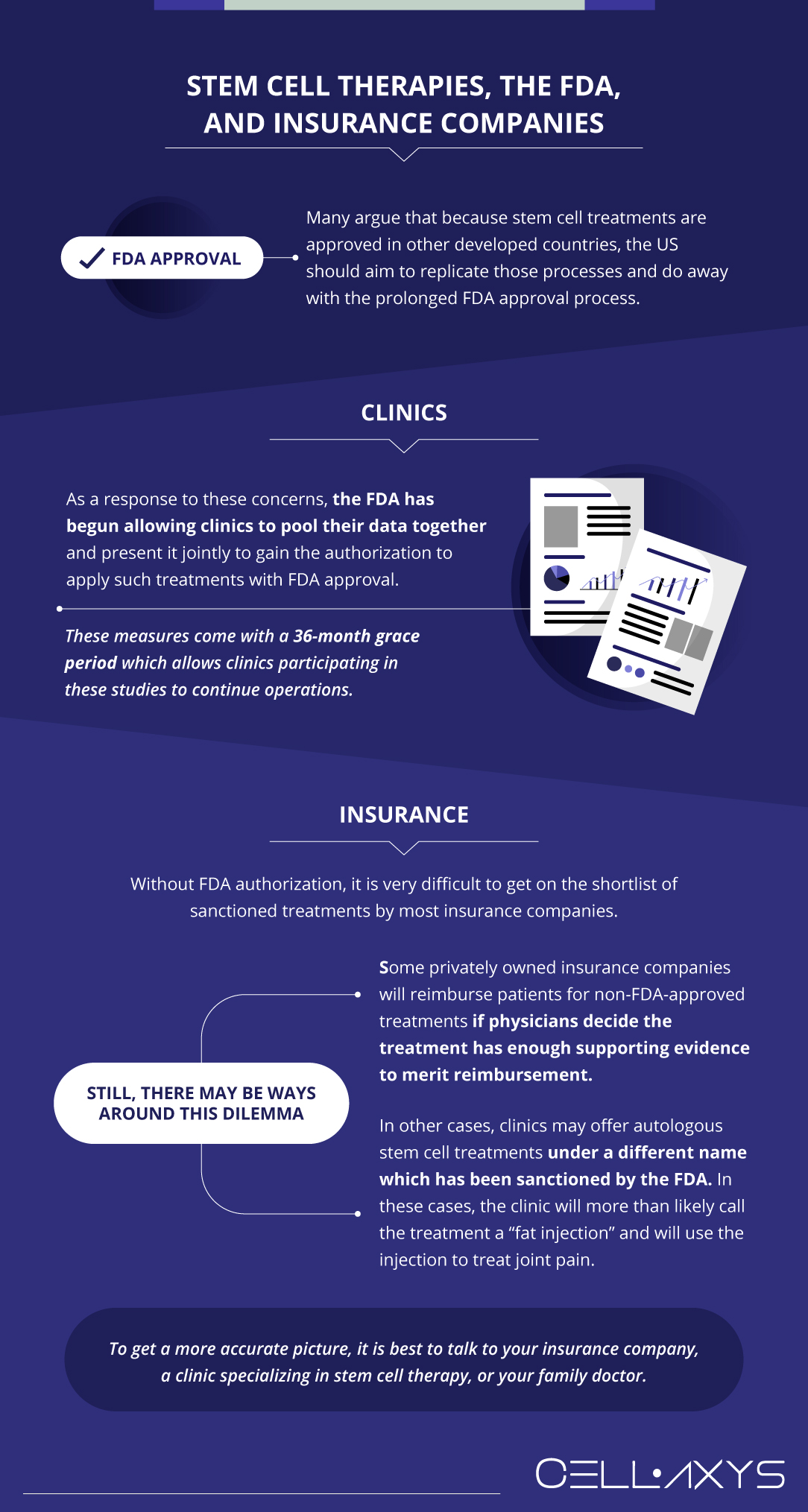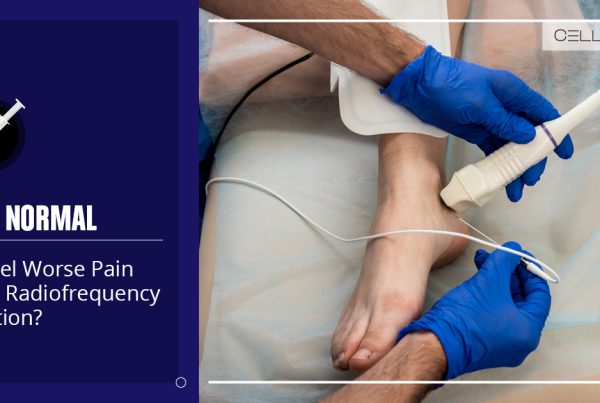Published on: February 19, 2020 | Updated on: August 29, 2024
Over the last decade, the buzz around autologous stem cell therapies has begun to pick back up. These innovative treatments aim to cure anything from chronic joint pain to degenerative heart, brain, and bone illnesses.
While much clinical work is left to be done, the question on most of our patients’ minds when they enter the CELLAXYS facility is:
“Are stem cell therapies covered by insurance?”
The short answer is no, but there are instances where there may be some kind of coverage.
Background: Stem Cell Therapies in the US
While embryonic stem cell treatments have been around for several decades, it was only recently that researchers discovered a way to induce a stem-cell-like state in healthy adult cells. This discovery led to a less ethically ambiguous source for stem cells and reignited the scientific community’s interest in stem cell treatments.
This new method of deriving stem cells takes blood, adipose (fat) tissue, or bone marrow from an adult and induces an infantile state in the tissues which allows them to change into various other tissues in the human body. The new cells created through this process are known as induced pluripotent stem cells.
Worldwide, induced pluripotent stem cells, or IPSCs, have garnered a lot of praise from medical and scientific communities alike. Germany and Japan are at the forefront of the development of therapies around IPSCs, while the US is quickly gaining pace.
Treatments using IPSCs are fairly new to the US and are still undergoing the rigorous approval process by the FDA. So, while other countries have begun to approve the application of these treatments, in the US, laboratories are still demonstrating their data to prove that such medicines are safe and effective by US standards.
Stem Cell Therapies, the FDA, and Insurance Companies

Many argue that because stem cell treatments are approved in other developed countries, the US should aim to replicate those processes and do away with the prolonged FDA approval process or be left in the wake of massive discoveries in the years to come.
The push for approval has been so strong recently that the FDA has enabled a seemingly less complicated way to get its approval.
In most cases, treatments undergo several years of clinical trials and may cost millions of dollars before gaining the FDA’s blessing. While these measures help ensure patient safety and treatment efficacy, they are also quite daunting for privately owned clinics to process.
As a response to these concerns, the FDA has begun allowing clinics to pool their data together and present it jointly to gain the authorization to apply such treatments with FDA approval.
These measures come with a 36-month grace period which allows clinics participating in these studies to continue operations. Thus, clinics specializing in autologous stem cell therapies are technically allowed to operate in the US, albeit without FDA approval for their treatments.
And it is with this FDA approval that insurance comes into play. Without FDA authorization, it is very difficult to get on the shortlist of sanctioned treatments by most insurance companies, and if a treatment isn’t sanctioned by a person’s insurance, then they will most likely not get reimbursed for the treatment.
Still, there may be ways around this dilemma. For instance, some privately owned insurance companies will reimburse patients for non-FDA-approved treatments if physicians decide the treatment has enough supporting evidence to merit reimbursement.
In other cases, clinics may offer autologous stem cell treatments under a different name which has been sanctioned by the FDA. In these cases, the clinic will more than likely call the treatment a “fat injection” and will use the injection to treat joint pain. These injections are IPSCs that have been extracted from adipose (fat) tissue.
While most insurance companies will not cover stem cell therapies, there may be methods to get around these limits and receive reimbursement for these procedures.
To get a more accurate picture, it is best to talk to your insurance company, a clinic specializing in stem cell therapy, or your family doctor.
The Future of Autologous Stem Cell Therapies
While most stem cell therapies have not yet been approved by the FDA, research around the subject in the US is rapidly developing and strides are being made for universal acceptance of these treatments.
The FDA has already begun to approve some of the products being clinically tested as part of their new regulations.
Some forms of stem cell treatment have even been approved. Stem cell therapies such as those for leukemia are already FDA sanctioned and covered by most medical insurance companies.
Additionally, US clinical trials of stem cell therapies are at an all-time high. Treatments are being tested for a range of issues, from kidney disease to osteoarthritis, and beyond. Similar treatments have already undergone the clinical and approval process in other countries and have been accepted as safe and effective, so the outlook for these US trials is mostly positive.
Though these processes are all indicative of rapid interest and acceptance of these treatments, none is more promising than the strides being made in the private insurance sector. According to the Employee Benefit Research Center (EBRC), over half of the US workforce insured through their employer fall under such plans.
The benefit to these types of targeted plans over large, subsidized insurance policies, is that they have the power to decide which treatments shall receive reimbursement on a case-by-case basis. With this in mind, employees have a much wider range of options available to them for their particular medical issue, including stem cell treatments.
The same EBRC article indicates that private health insurance is a growing trend and that many small, privately owned clinics (such as CELLAXYS) are marketing their services to these employer-provided insurance policies and rapidly gaining approval for reimbursement.
If you would like more information about autologous stem cell treatments or need help determining if your insurance policy may cover these treatments, contact the CELLAXYS offices today.
Sources
Footnotes
- Akabayashi A, Nakazawa E, Jecker NS. What are considered ‘good facts’?. Journal of medical ethics. 2019;45(7):473-5.
- Cyranoski D. ‘Reprogrammed’ stem cells approved to mend human hearts for the first time. Nature. 2018;557(7706):619-.
- Ravi G, Chamoun K, Boughan KM, Cao S, Fu P, de Lima M, Malek E. Stem cell transplant minimizes insurance coverage-driven outcomes disparities for multiple myeloma patients. Blood. 2019;134:424.
- Tan SS, Ng ZY, Zhan W, Rozen W. Role of adipose-derived stem cells in fat grafting and reconstructive surgery. Journal of cutaneous and aesthetic surgery. 2016;9(3):152.
- Weiss JN. Multicenter Trial of Stem Cell Therapy for Osteoarthritis (MILES). InOrthopedic Stem Cell Surgery 2021 (pp. 59-64). Cham: Springer International Publishing.
- Fronstin P. Self-Insured Health Plans: Recent Trends by Firm Size, 1996‒2016. EBRI Issue Brief. 2018(442).
References
- Harvard and Japanese researchers create embryonic stem cells without embryo. Harvard Stem Cell Institute. Accessed 2/25/2024.
- FDA’s Framework for Regulating Regenerative Medicine Will Improve Oversight. Pew. Accessed 2/25/2024.
- Japan OKs Medipost’s P2 trial of stem cell-serviced osteoarthritis treatment. Korea Biomedical Review. Accessed 2/25/2024.
- Approved Cellular and Gene Therapy Products. FDA. Accessed 2/25/2024.
- Stem cell transplantation for leukemia. City of Hope. Accessed 2/25/2024.
- Clinical trial of stem cell therapy for traumatic spinal cord injury. Mayo Clinic. Accessed 2/25/2024.
CELLAXYS does not offer Stem Cell Therapy as a cure for any medical condition. No statements or treatments presented by Cellaxys have been evaluated or approved by the Food and Drug Administration (FDA). This site contains no medical advice. All statements and opinions are provided for educational and informational purposes only.
Dr Pejman Bady
Author
Dr. Pejman Bady began his career over 20 years ago in Family/Emergency Medicine, working in fast-paced emergency departments in Nevada and Kansas. He has served the people of Las Vegas as a physician for over two decades. Throughout this time, he has been met with much acclaim and is now the head of Emergency Medical Services in Nye County, Nevada. More about the doctor on this page.
Dr Pouya Mohajer
Contributor
Pouya Mohajer, M.D. is the Director of Spine and Interventional Medicine for CELLAXYS: Age, Regenerative, and Interventional Medicine Centers. He has over 20 years of experience in pain management, perioperative medicine, and anesthesiology. Dr. Mohajer founded and is the Medical Director of Southern Nevada Pain Specialists and PRIMMED Clinics. He has dedicated his career to surgical innovation and scientific advancement. More about the doctor on this page.









